Jill Robinson, Clemson University, Jill6@clemson.edu
K. Dale Layfield, Clemson University, dlayfie@clemson.edu
Christopher J. Eck, Oklahoma State University, Chris.eck@oksate.edu
Stephen Cole, Clemson University, scole3@clemson.edu
Abstract
Organic farming has seen a dramatic increase over the last decade and is now practiced all over the world. With this new and innovative farming style growing in demand, it creates a greater need for education and resources for farmers. This study was undergirded by the diffusions of innovations theory, as the Cooperative Extension service aids in the diffusion of practical agricultural information throughout the United States. The purpose of this study is to determine the educational resources necessary for organic farmers. By assessing the community needs, the data can be used to provide cooperative extension with educational materials to help aid organic farmers. A Borich needs assessment was developed to conduct this non-experimental research study through a survey research design, which allowed researchers to rank the educational need. The results of this study indicate that educational resources need to be developed and geared toward managing organic crop diseases, insect pests and weeds in an organic farming system. Extension services play a major role in diffusion of technology and educational resources, as agents need to provide educational resources for organic farmers in addition to conventional farmers. Additionally, educational materials need to be developed to better educate consumers on organic farming and what it means to be certified organic. It is further recommended that an educational needs assessment be performed on extension agents to determine their educational gaps when dealing with organic competencies, bridging the gap between organic education and extension. These findings are very insightful for extension services and other educational agencies to understand where the largest educational need is.
Introduction and Theoretical Framework
The renewed emphasis on environmental protection and agricultural sustainability has created a new wave of interest in organic agriculture (McNeil, 2020). Organic agriculture can be defined as an ecological production management system that promotes and enhances biodiversity, biological cycles, and soil biological activity (USDA National Organic Standards Board), which is based on minimal inputs and best management practices that restore, maintain, and enhance ecological harmony (Gold, 2007). Thus, organic farming has increased over the last decade and is now practiced all over the world, with global organic sales reaching $55.1 billion in 2019 (McNeil, 2020). In the U.S., 8.3 million acres are currently certified for organic production, and the organic marketplace allows smaller scale operations and new generation farmers to contribute to global agricultural production (Knutson, 2019).
As organic agriculture continues to grow, the need for education and resources for farmers grows. The Smith-Lever Act in 1914 established Cooperative Extension as part of the land-grant universities, which aim to serve agricultural producers in the state as an educational resource by providing research-based information (Scholl, 2013). Specifically, Clemson University has the obligation ‘‘to teach such branches of learning as are related to agriculture and the mechanical arts… in order to promote the liberal and practical education of the industrial classes in the several pursuits and professions in life’’ (Act M, 1862). Land grant universities were set up with the intention of providing agricultural education to citizens in the state, with organic farming emerging with unique regulations and required skillsets. Land grant universities need to fulfill their role as an educational resource for these organic farmers. Additionally, literature is lacking on the educational resources being implemented for organic farmers, therefore this study aimed to identify the necessary educational resources for organic farmers.
The continued adoption of organic agriculture will be influenced by policy measures that improve farming education and promote environmental mindfulness, such as farm output diversification. Therefore, this study was undergirded by the diffusions of innovations theory (Rogers, 2003), as the Cooperative Extension service aids in the diffusion of practical agricultural information throughout the United States (Hillison, 1996). Communication channels and networks play a huge role in facilitating the education to farmers with advanced extension services, organized workshops, and round table meetings among farmers and rural stakeholders (Genius & Pantzios, 2006), ultimately leading to a sustainable adoption (Rogers, 2003) of organic agricultural practices. Currently in South Carolina, increasing demand for organic products helps in the decision process to adopt organic agriculture, while the extensive list of regulations set forth can limit the continual implementation of the process (Rogers, 2003). Known barriers exist within the innovation decision process, including, producing organic crops with alternative pest management solutions, increasing soil fertility, following organic regulations, and implementing no-till methods. Additionally, two of Rogers’ (2003) attributes of innovation, trialability and observability, established educational practices of the Cooperative Extension service, help reduce uncertainty about innovations such as organic farming practices. With the proper knowledge, farmers may use small plots of land for their own trials before seeking organic certification. Therefore, it is essential to develop educational material, field trials and training targeted at organic farmers to provide the necessary knowledge to help in the decision and implementation process related to the diffusion of organic agriculture (Rogers, 2003). Specifically, this research aims to understand organic agriculturalists and their needs in South Carolina.
Purpose/Objectives
The purpose of this study was to determine the educational resources necessary for organic farmers. By assessing the needs, the data can be used to provide cooperative extension with educational materials to help aid organic farmers. Three objectives guided this study:
- Determine the personal and professional demographics of certified organic farmers in South Carolina,
- Determine the educational resource needs and preferred method of receiving educational resources, and
- Determine organic farmers’ perceived growth and barriers of organic farming.
Methods
A Borich needs assessment was developed to conduct this non-experimental research study, aimed at determining the educational needs based upon a discrepancy model (Borich, 1980). This study implemented a survey research design, which could then be weighted and ranked in order of educational need priority.
Participants
A census approach was implemented to reach South Carolina organic farmers who have been certified through the Clemson University Organic Certification Program (N = 41). The frame was obtained from the Clemson University Organic Certification Program, all 41 certified organic farmers in South Carolina were contacted and had equal opportunity to participate. The electronic survey was distributed via email with a letter explaining the survey’s purpose and a link to the Qualtrics survey.
Instrumentation
The needs assessment was adapted from Frick’s (2008) Needs Assessment of Saskatchewan Organic Farmers to meet the organic needs in United States. The survey consisted of a Borich needs assessment with Likert scale questions and open-ended questions to gain an understanding of what educational resources the organic farmers needed. The results identify the discrepancy between organic growers’ self-perceived skill level and their desired interest level on organic farming competencies. The survey questions were divided into three main groups to coincide with the objectives. The first set of questions covered basic demographics, including organic crops grown, total number of acres cultivated, gross revenue, farming experience, age, education level, gender, and location. The second set of questions focused on integral components of organic farming. These questions were divided up into the following categories: natural resources & biodiversity, land requirements, managing soil fertility and soil quality, managing weeds, managing crop insect pests, managing crop diseases, crop rotation and postproduction needs. The third set of questions asked the participants to identify their preferred method for receiving educational materials.
Procedure
The survey was evaluated for content validity by a panel of experts in organic agriculture to ensure the survey questions were relevant to organic produces in South Carolina. In addition, faculty in agricultural and extension education reviewed the instrument for face validity based on their experience with survey design and implementation. Prior to survey distribution, the study was approved by the Clemson University IRB office. Once approved, the initial email was sent to organic farmers in South Carolina (N = 41) requesting their participation in the study. Following the tailored design method (Dillman et al., 2014), a second email was distributed two weeks later, followed by a final reminder email two weeks after that. After three rounds of email communication with organic farmers, a final attempt was made to solicit responses via phone, where the farmers were encouraged to participate in the survey that was distributed. Although responses were anonymous, participant email address were recorded to help collect data from non-respondents.
Data Analysis
Following data collection, SPSS Version 26 was used for descriptive data analysis. Microsoft Excel was implemented to calculate a mean weighted discrepancy score (MWDS) between current skill level and desired interest level. The organic competencies were then ranked using the mean weighted discrepancy scores.
Findings
Objective 1: Determine the professional and personal demographics of certified organic farmers in South Carolina
The survey had a 69% (n = 29) response rate. The responding organic farmers revealed that nearly half (48%) have been certified organic farmers for less than five years. The survey also revealed that nearly half (44.8%) of farmers make over $50,000 in gross organic sales. Nearly all (89.9%) the organic farmers are older than 41 with over half (58.6%) of them having completed a bachelor’s degree or higher. The majority (75.9%) of organic farmers are male. The most common organic crops are cucumber, squash, lettuce, tomato, and peppers, all of which producers intend on growing in the future with 55.2% of farmers stating they do not intend to change what they are already producing. The respondents were distributed across 21 counties in South Carolina with varying land sizes (see Table 1).
Table 1
Acreage Allocation of Organic Farmers
| # Acres | # Farmers with Cultivated Acres | # Farmers with Other Acres (Forests, Natural Areas, etc.) | # Farmers with Certified Organic Acres |
| 0-1.99 | 7 | 13 | 4 |
| 2-5.99 | 5 | 0 | 5 |
| 6-9.99 | 5 | 1 | 5 |
| 10-19.99 | 4 | 2 | 1 |
| 20-49.99 | 3 | 0 | 4 |
| 50-99.99 | 4 | 6 | 5 |
| 100-499.99 | 1 | 4 | 1 |
| 500-999.99 | 1 | 1 | 2 |
| 1,000-6,000 | 2 | 2 | 1 |
The greatest numbers of organic crops grown in South Carolina are tied between cucumber, pepper, and tomato with seventeen of the organic farmers producing these crops (see Table 2). Sixteen of the organic farmers indicated they produce lettuce and squash, while the least grown crops were melon (10), onion (9), corn (8), asparagus (5), and small grain (5). Three organic farmers intend to add carrot, berry, potato, and asparagus to their list, although the majority (n = 16) have no intentions to change their current acreage (see Table 2).
Table 2
Frequencies of Current and Intended Addition of Crops Produced by Organic Crop Farmers
| Organic Crop Type | # of Organic Farmers Currently Producing | # of Organic Farmers Intending to Produce Crop |
| Cucumber | 17 | 1 |
| Pepper | 17 | 1 |
| Tomato | 17 | 1 |
| Lettuce | 16 | 0 |
| Squash | 16 | 1 |
| Bean | 15 | 0 |
| Brassica | 14 | 1 |
| Okra | 14 | 0 |
| Broccoli | 13 | 2 |
| Carrot | 12 | 3 |
| Herb | 12 | 1 |
| Berry | 11 | 3 |
| Potato | 11 | 3 |
| Melon | 10 | 2 |
| Onion | 9 | 1 |
| Corn | 8 | 1 |
| Asparagus | 5 | 3 |
| Small grain | 5 | 3 |
| Hemp | 4 | 1 |
| Stone fruit | 3 | 2 |
| Apple | 1 | 1 |
Objective 2: Determine the educational resource needs and preferred method of receiving educational resources
Natural Resources & Biodiversity
The educational needs related to natural resources and biodiversity (Table 3) are wetland wildlife habitat management and removal of invasive species. Education programs should focus on these two educational areas and potentially partner up with DNR or Clemson University Invasive Species Program to cover these two topics. Organic farmers are confident in their upland wildlife habitat management and tree/shrub establishment skills.
Table 3
Rankings of Organic Farmers’ Competency Ratings of Natural Resources and Biodiversity Skills Using the Borich Needs Assessment Model (n = 26)
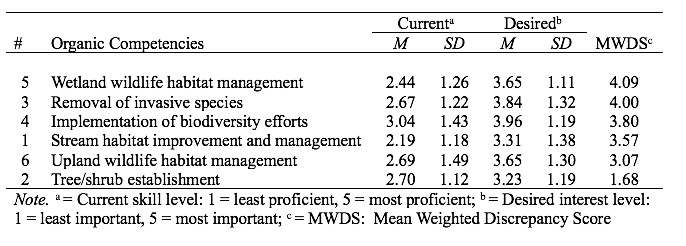
Land Requirements
The highest MWDSs for educational need (Table 4) for land requirements are field border development and riparian forest buffer management. Organic farmers are confident in their buffer zone development skills.
Table 4
Rankings of Organic Farmers’ Competency Ratings of Land Requirements Skills Using the Borich Needs Assessment Model (n = 26)

Managing Soil Fertility and Soil Quality
The highest need of educational resources (Table 5) in managing soil fertility and soil quality are soil biology management to improve existing soil life and soil chemistry management as determined by the MWDS. When developing these resources, soil chemists could be utilized as experts on these topics. The organic farmers are confident in their ability to minimize soil erosion.
Table 5
Rankings of Organic Farmers’ Competency Ratings of Managing Soil Fertility and Soil Quality Skills Using the Borich Needs Assessment Model (n = 26)
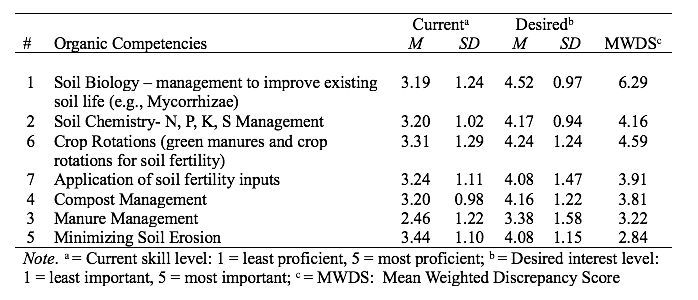
Managing Weeds
The top three educational needs (Table 6) from managing weeds are using biological weed controls (natural and introduced diseases and predators of weeds), designing weed control programs to manage specific weeds, and using cultural weed controls (seeding rates, varieties, cropping management). Organic farmers believe they have a strong skill set in using mechanical weed controls.
Table 6
Rankings of Organic Farmers’ Competency Ratings of Managing Weeds Skills Using the Borich Needs Assessment Model (n = 26)

Managing Crop Insect Pests
The top three educational needs (Table 7) are designing pest control programs to manage specific weeds, enhancing natural pest controls (i.e., encouraging beneficial insects) and using biological pest controls (e.g. releasing insect diseases or predators). The organic farmers have a strong perceived skill level of using mechanical pest control.
Table 7
Rankings of Organic Farmers’ Competency Ratings of Managing Crop Insect Pest Skills Using the Borich Needs Assessment Model (n = 26)
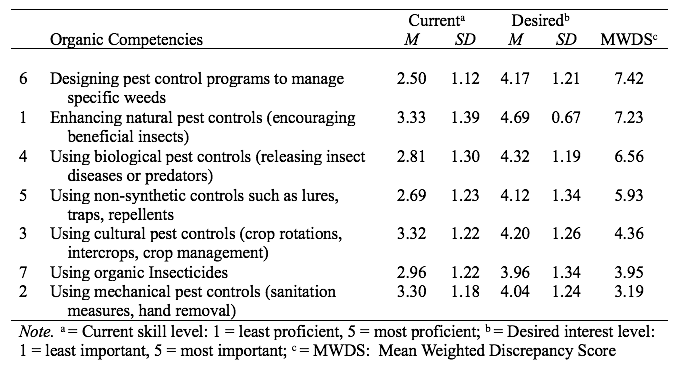
Managing Crop Diseases
The top two educational resource needs for managing crop diseases (Table 8) are enhancing natural disease controls and improving habitats for natural enemies of pests. The lowest educational need is using cultural disease controls.
Table 8
Rankings of Organic Farmers’ Competency Ratings of Managing Crop Disease Skills Using the Borich Needs Assessment Model (n = 26)

Crop Rotation
The highest educational need in crop rotation (Table 9) is understanding soil, weed, insect and disease interactions in rotations. The lowest educational resource need is identifying crop rotations that provide erosion control.
Table 9
Rankings of Organic Farmers’ Competency Ratings of Managing Crop Rotation Skills Using the Borich Needs Assessment Model (n = 26)
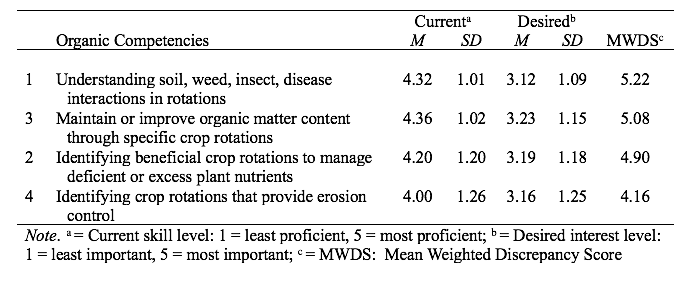
Post-Production Needs
The highest educational resource need (Table 10) is processing facilities for organic field crops and information on the buyers who are consuming organic foods. The lowest educational resource need is consumer education on organic standards.
Table 10
Rankings of Organic Farmers’ Competency Ratings of Managing Post-Production Skills Using the Borich Needs Assessment Model (n = 26)
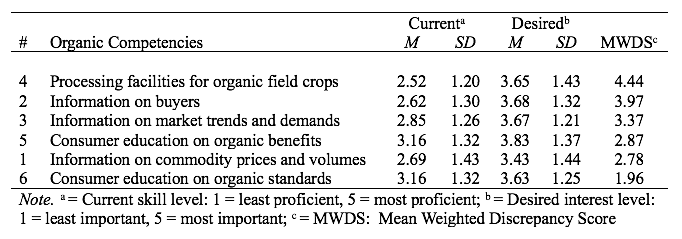
Objective 3:Determine organic farmers’ perceived growth and barriers for organic farming.
The third objective was to determine how organic farmers would like to receive educational resources and what barriers and growths do they see for organic farming. A majority (79.3%) of organic farmers indicated they would like the educational resource to be an electronic form (i.e., email, website, orwebinar), while only a small percentage (13.8%) indicated they would like to have personal contact through workshops or farm tours to answer specific questions they have. The remaining 6.9% preferred mail correspondence with educational materials.
The organic farmers were also asked what they percieved to be barriers and opportunities of growth for organic farming. The common barrier stated was lack of education on the consumer side on what organic truly means. One farmer stated “The general misunderstanding of the general public of what organic really “is” especially in confusing organic and local. The public does not understand the extra costs of production or benefits to themselves and the benefits to the local environment and workers for organic production.” An additional barrier mentioned was being able to adapt the individual growing environment for individual species. Another farmer stated “The barrier that I see would be the ongoing knowledge that it takes to adapt to ones growing environment for each individual growing species. Knowing what plants would be beneficial to grow together to help ward off pests would help break down the barrier on achieving success.” The opportunities for growth that the farmers stated was society’s push for healthier food options and becoming more aware of where their food is coming from. One farmer stated “As everyone seems to be more health conscious. I believe the ability to adapt and lower production costs would be greatly accepted by buyers. As we all continue to learn not just the basics but more advanced organic growing, I feel that Organics will only become more affordable and prosperous.” Another opportunity of growth would be educating the consumer on what organic certification really is and what it entials. One farmer stated “The opportunity depends on the education of the public on the benefits on all levels including why customers should patronize them to ensure that the benefits occur. Stressing the difference between local organic and local.” The final opportunity of growth that the organic farmers percieve is developing more educational resources related to organic farming, one farmer stated “get extension teams more educated will help make it easier for farmers to try and do organics as there are many questions.”
Conclusions, Discussion, and Recommendations
This study mirriored the results of Frick et al. (2008), as South Carolina Organic farmers top areas of need included soil fertility and understanding integrated pest management plans that comabt weeds, insects and diseases. The barriers percieved by the Saskatchewan farmers were similair to the ones discovered in this study including the misrepresentation and lack of understanding of what organic farming is by the public. The growth of organics has renwed the public interest in food sustainability, which is a great opportunity for organic agriculture.
Extension services play a major role in diffusion of technology and educational resources, as agents need to provide educational resources for organic farmers in additon to conventional farmers. This Extension professional serves as change agents in the adoption of new technology, ultimately promtoing the initial addoption by reduces barriers, providing observability, and supporting farmers for continual adoptionof the technology and practices (Rogers, 2003). The results of our needs assesment suggest organic farmers need educational resources related to §205.206(a)(b)(c) Managing Crop weeds, Insect Pests and Diseases. With focus on the organic competencies of using biological weed controls designing weed control programs to manage specific weeds, designing pest control programs to manage specific weeds, enhancing natural pest controls, enhancing natural disease controls and improving habitats for natural enemies of pests. Current extension programs could adjust and redesign their current education programs and trainings to help close the educational gaps that organic farmers are currently facing. It is reccomended that extension programs create in-depth organic pest management trainings that meet the needs described above and identify exisiting resources and educational materials. Additionally, industry professionals (i.e., soil scientists, organic speciailists, IPM professionsals) should be utilized to cover these topics. Other state extension programs and educational groups should implement similar topics into their educational programs.
Many findings were related to farmer’s needs relating to different cultural practices of organic crops, including field border development, soil biology management, and designing pest control programs to manage specific weeds. Therefore, it is essnetial for the continuation of field trials on various cultivars of organic crops across South Carolina to continue to support organic farmers. These trials provide opportunites for innovation across organic agriculture and provide opportunities for observability, reducing the barriers to adoption (Rogers, 2003). It is recommended that South Carolina Cooperative Extension agents coordinate closely with organic crop researchers at Clemson University when field days are held to generate awareness and attendance of organic farmers in their respective regions. Further, Cooperative Extension agents may consider developing virtual field days for organic farmers as were held by many land grants across the U.S. during the COVID-19 pandemic.
Furthermore the comments written by the organic farmers suggests there needs to be more education provided to the public on what organic farming is, the disconnect between the public and organic farming was seen as a major barrier to organic growth. Ultimately, education is a pivotal component in the future success of organic production, as the continued adoption of organic agriculture will be influenced by policy decisions often impact by public opinion. Knowing this, extension services are encouraged to provide more general educational materials to the public, discussing what organic farming is and correcting misconceptions, perhaps integrating organic farming concepts into their youth and adult agriculutral programs.
It is reccomended that the needs assesment used in this study be admistered to Extension agents to determine their educaitonal gaps related to organic compentcies. Improving the current gap between organic education and extension agents. This research was developed to better understand the education gaps for organic farming. These results show that educational resources need to be developed and geared toward managing organic crop diseases, insect pests and weeds in an organic farming system. Additionally, educational materials need to be developed to better educate consumers on organic farming and what it means to be certified organic. These findings are very insightful for extension services and other educational agencies to understand where the largest educational need is. The survey revealed electronic form is the most desired vessel of education. This will be key when developing educational materials that farmers will utilize. Altough this study is limited to organic farmers in South Carolina, other states with organic programs should consdier the findings and conclusions of this study to help guide future implmentation and practices. Replicating this study on a state by state basis would be beneficial to further understand the educational needs, barriers, and opportunites for growth within the organic agricultre community.
References
Act, M. (1862). Thirty-Seventh US Congress. Session II
Borich, G. D. (1980). A needs assessment model for conducting follow-up studies. The Journal of Teacher Education, 31(3), 39–42. https://doi.org/10.1177/002248718003100310
Dillman, D. A., Smyth, J. D., & Christian, L. M. (2014). Internet, phone, mail, and mixed-mode surveys: the tailored design method. John Wiley & Sons.
Elhamoly, A. I. M. A, Koledoye, G. F, & Kamel, A. (2014). Assessment of training needs for Egyptian extension specialists (SMSs) in organic farming field: Use of the Borich needs model. Journal of Agricultural & Food Information, 15, 180–190. https://doi.org/10.1080/10496505.2014.921110
Fernandez-Cornejo, J., Nehring, R. F., Osteen, C., Wechsler, S., Martin, A., & Vialou, A. (2014). Pesticide use in US agriculture: 21 selected crops, 1960–2008. USDA-ERS Economic Information Bulletin, 124. http://dx.doi.org/10.2139/ssrn.2502986
Frick, B., Beavers, R., Hammermeister, A., & Thiessen-Martens, J. R. (2008). Research needs assessment of Saskatchewan organic farmers. University of Saskatchewan, Saskatoon, SK. https://cdn.dal.ca/content/dam/dalhousie/pdf/faculty/agriculture/oacc/en/research-priorities/Canadian_Organic_Research_Needs_Survey_Saskatchewan_2008.pdf
Genius, M., Pantzios, C. J., & Tzouvelekas, V. (2006). Information acquisition and adoption of organic farming practices. Journal of Agricultural and Resource economics, 31(1), 93–113. https://www.jstor.org/stable/pdf/40987308.pdf
Gold, M. (2007). Organic production/organic food: Information access tools. https://www.nal.usda.gov/afsic/organic-productionorganic-food-information-access-tools
Harner, T., Pozo, K., Gouin, T., Macdonald, A. M., Hung, H., Cainey, J., & Peters, A. (2006). Global pilot study for persistent organic pollutants (POPs) using PUF disk passive air samplers. Environmental Pollution, 144(2), 445–452. https://doi.org/10.1016/j.envpol.2005.12.053
Hillison, J. (1996). Agricultural education and cooperative extension: The early agreements. Journal of Agricultural Education, 37, 9–14. https://doi.org/10.5032/jae.1996.01009
Knutson, J. (2019). Report: US organic acres set record. AG Week. https://www.agweek.com/business/agriculture/4657799-report-us-organic-acres-set-record
Lawson, M. (2008). The adult learner. In W. R. Yount (Ed.), The teaching ministry of the church (2nd ed., pp. 345–360). B&H Publishing.
McNeil, M. (2020). COVID-19 will shape organic industry in 2020 after banner year in 2019. Organic Trade Association. https://ota.com/news/press-releases/21328
Pimentel, D. (1995). Amounts of pesticides reaching target pests: environmental impacts and ethics. Journal of Agricultural and environmental Ethics, 8(1), 17–29. https://doi.org/10.1007/BF02286399
Rogers, E. M. (2003). Diffusions of Innovations (5th ed.). Free press.
Scholl, J. (2013). Extension family and consumer sciences: Why it was included in the Smith-Lever Act of 1914. Journal of Family and Consumer Sciences, 105(4), 8–16. https://doi.org/10.14307/JFCS105.4.5
Warner, P. C. (2019). Cooperative Extension Service: A National Assessment. Routledge.